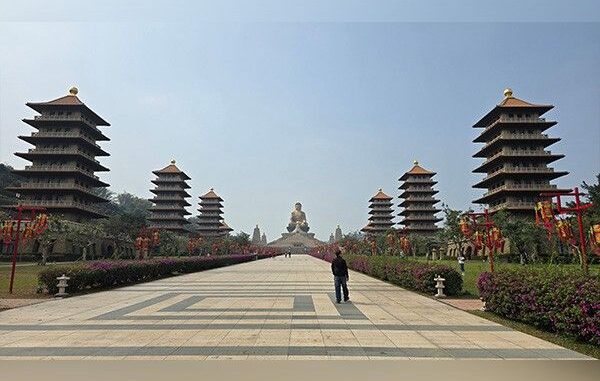
KAOHSIUNG, Taiwan — Even if one is not Buddhist, the Fo Guang Shan Buddha Museum in Dashu District in Kaohsiung is welcoming visitors and provides a glimpse into Buddhism.
As a traveler that hails from a majority Catholic country that has an abundance of century-old stone churches, it is a curious learning exercise to visit the renowned Kaohsiung Buddhist complex.
Philstar.com was among those invited to cover the Lantern Festival earlier this year in Tainan, Taiwan. A trip to the museum, located in the nearby city of Kaohsiung, was included in the itinerary. Both cities are in the southeastern part of Taiwan, while the capital Taipei lies in the northernmost tip of the island country.
The first impression this writer had upon walking under its pagoda archway is its magnificence. It could not be wrong, though, for as one goes on inside the complex, a lot of things seem shining in bright gold and are gigantic.
Near the entrance is a commercial space where souvenir shops and dining establishments are located. Once through it, one can then proceed to do the long march toward the Grand Buddha, which looms even at a distance from the starting point of the pathway leading to it.
The landscape featuring the giant Buddha and the multi-tiered pagodas on the side make a picturesque sight. While one walks toward it, there is a sense of foreboding of the Buddha being able to read one’s thoughts. As one nears it, one cannot also help at the architectural marvel on how it was constructed in the first place.
There is a main hall that houses relevant exhibits. On the lobby is the Five Hundred Arhat artwork, sculpted from the roots of a thousand-year-old camphor tree. It took two years to sculpt and was donated as part of the museum’s permanent exhibition.
According to the museum’s notes, the Five Hundred Arhats refer to the 500 sravakas (disciple) who have attained the stage of no more learning.
A courtyard is placed directly in front of the Buddha statue.
Pagodas are said to symbolize enlightenment in Buddhism, and the experience of walking in the Grand Buddha complex’s environs is conducive to it. Each of the pagodas has its own purpose. For instance, visitors at the Samantabhadra Pagoda are enjoined to take heart about the concepts of karma (action driven by intention which leads to future consequences) and dharma (doctrine about universal truth). It calls on believers to dedicate their merits and virtue to all sentient beings.
Travel affords a new worldview far different from one’s origin, especially if one visits a foreign country that has a different set of cultures and norms.
Temple visits, such as in Fo Guang Shan Buddha Museum in Kaohsiung, do not need one to be a believer. It is enough to be able to see, learn, and perhaps, be enlightened about the world’s many beliefs.
—
Editor’s note: The tour to Taiwan was hosted by Taiwan Tourism Administration to promote tourism in the area. At no stage does the host organization have a say on the stories generated from the coverage, interviews conducted, publication date and story treatment. Content is produced solely by Philstar.com following editorial guidelines.
RELATED: In photos: Taiwan’s Lantern Festival comes to Tainan


Be the first to comment